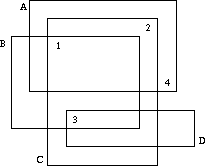poj1486 Sorting Slides
| Time Limit: 1000MS | Memory Limit: 10000K | |
| Total Submissions: 4812 | Accepted: 1882 |
Description
The situation is like this. The slides all have numbers written on them according to their order in the talk. Since the slides lie on each other and are transparent, one cannot see on which slide each number is written. 
Well, one cannot see on which slide a number is written, but one may deduce which numbers are written on which slides. If we label the slides which characters A, B, C, ... as in the figure above, it is obvious that D has number 3, B has number 1, C number 2 and A number 4.
Your task, should you choose to accept it, is to write a program that automates this process.
Input
This is followed by n lines containing two integers each, the x- and y-coordinates of the n numbers printed on the slides. The first coordinate pair will be for number 1, the next pair for 2, etc. No number will lie on a slide boundary.
The input is terminated by a heap description starting with n = 0, which should not be processed.
Output
If no matchings can be determined from the input, just print the word none on a line by itself.
Output a blank line after each test case.
Sample Input
4
6 22 10 20
4 18 6 16
8 20 2 18
10 24 4 8
9 15
19 17
11 7
21 11
2
0 2 0 2
0 2 0 2
1 1
1 1
0
Sample Output
Heap 1
(A,4) (B,1) (C,2) (D,3) Heap 2
none
Source
#include <cstdio>
#include <cstring>
#include <iostream>
#include <algorithm> using namespace std; int n,a[][],pipei[],flag[],can[][],cnt,ans[][],cas;
int pipei2[];
bool print = false;
struct node
{
int minx,maxx,miny,maxy;
} e[];
struct node2
{
int x,y;
} point[]; bool dfs(int u)
{
for (int i = ; i <= n; i++)
if (a[u][i] && !flag[i])
{
flag[i] = ;
if (!pipei[i] || dfs(pipei[i]))
{
pipei[i] = u;
return true;
}
}
return false;
} bool dfs2(int u)
{
for (int i = ; i <= n; i++)
if (a[u][i] && !flag[i])
{
flag[i] = ;
if (!pipei2[i] || dfs2(pipei2[i]))
{
pipei2[i] = u;
return true;
}
}
return false;
} int main()
{
while (scanf("%d",&n) && n)
{
memset(pipei,,sizeof(pipei));
memset(can,,sizeof(can));
memset(ans,,sizeof(ans));
memset(a,,sizeof(a));
cnt = ;
print = false;
for (int i = ; i <= n; i++)
scanf("%d%d%d%d",&e[i].minx,&e[i].maxx,&e[i].miny,&e[i].maxy);
for (int i = ; i <= n; i++)
scanf("%d%d",&point[i].x,&point[i].y);
for (int i = ; i <= n; i++)
for (int j = ; j <= n; j++)
if (point[j].x >= e[i].minx && point[j].x <= e[i].maxx && point[j].y >= e[i].miny && point[j].y <= e[i].maxy)
a[j][i] = ;
for (int i = ; i <= n; i++)
{
memset(flag,,sizeof(flag));
if (dfs(i))
cnt++;
}
for (int i = ; i <= n; i++)
{
a[pipei[i]][i] = ;
int cnt2 = ;
memset(pipei2,,sizeof(pipei2));
for (int j = ; j <= n; j++)
{
memset(flag,,sizeof(flag));
if(dfs2(j))
cnt2++;
}
if (cnt2 < cnt)
ans[i][pipei[i]] = ;
a[pipei[i]][i] = ;
}
printf("Heap %d\n",++cas);
for (int i = ; i <= n; i++)
if (ans[i][pipei[i]])
{
print = true;
printf("(%c,%d) ",'A' + i - ,pipei[i]);
}
if (!print)
printf("none");
printf("\n\n");
} return ;
}
最新文章
- Expert 诊断优化系列------------------冤枉磁盘了
- Regex Expression的资料和笔记整理
- uva 10491
- SCU3502 The Almost Lucky Number
- FluentMigrator
- 开源Asp.Net MVC网上商城BrnShop
- 重拾Ruby—新的征程
- C++中堆和栈的完全解析(转)
- js内置函数大全及基本使用方法(一)
- 201621123060《JAVA程序设计》第二周学习总结
- 关于CSS引入方式的详细见解
- 【原创】大叔经验分享(17)编程实践对比Java vs Scala
- 2019你该掌握的开源日志管理平台ELK STACK
- 【转】fiddler抓包HTTPS请求
- Linux下的at定时执行任务命令详解
- 优步加入Linux基金会:支持开源
- Sql Server 修改表所属用户
- Java Spring+Mysql+Mybatis 实现用户登录注册功能
- eclipse集成Python开发环境
- MSMQ向远程服务器发送消息----错误总结